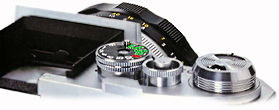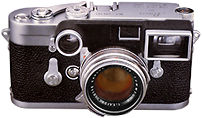 |
In 1959, Nikon wrought a revolution in photojournalism with the introduction of the Nikon F (then known simply as "The Nikon"). The revolution was years in the making, and heralded a number of changes, including: |
1. A shift towards
SLRs as the camera of choice for most professionals
2. A shift
towards 35mm as the film of choice for photojournalists
3. A shift
towards consumer acceptance of Japanese cameras
4. A shift towards a complete "camera system"
From Rangfinder to SLR
Single-lens reflex
cameras (SLRs) began to replace rangefinders (RFs) for a number of complex applications.
Although the concept of the eye-level SLR predates the 1959 Nikon F by at least eleven
years, with the 1948 Contax S taking those honors, SLRs were not given great acceptance
by professionals because of extra weight, reliability problems, and dim viewfinders,
compared with the standard of the day, the Leica M3. All of these reasons more than
offset, in their eyes, the added benefit of precise framing afforded by SLRs. Enter
the Nikon F.
The Nikon F incorporated a host of improvements over competing eye-level SLRs. Putting
both an automatic diaphragm and an instant-return mirror in made it the quickest
SLR to use. It had the same acclaimed control layout as the top-of-the-line Nikon
SP. The viewfinder was relatively bright, and evenly illuminated, thanks to the fresnel
lens integrated into the focussing screen. Compared to the solidly-built Contaflexes,
the Nikon felt every bit as solid while weighing considerably less. Since the final
body dimensions (except for depth) were quite close to those of the SP, here, finally,
was an SLR that could compete with RFs for ease of use and compactness.
 |
The 1957 Nikon SP and its system laid a solid foundation stone for the Nikon F, widely reagrded as the best Nikon rangefinder model, takes in Motor drive and an array of fine optics. As with all great cameras, the Nikon also had crisp, classic lines that are distinctive and to some eyes (mine, at least) beautiful. It has a purposeful, unmistakeable look about it that at once identifies it both as a tool and a jewel, a veritable gem among its slightly lumpier-looking SLR contemporaries. |
Although looks don't affect how a camera takes pictures, having such a one is almost like owning a Porsche: your Aunt Gert, who knows nothing about cameras/cars, immediately falls in love with the lines; Uncle Herb, who fancies himself a car/camera nut, immediately begins giving you more respect for knowing its capabilities, and commensurately, yours; random strangers will elbow their buddies and point and whisper furtively, wondering where you've put your press pass.
The Nikon's cause in the United States was helped in no small part by the genius of the distributor, Joe Ehrenreich, of Ehrenreich Photo-Optical Industries (EPOI, which was later bought by Nippon Kogaku and renamed Nikon USA). He saw to it that every major photojournalist in the US was seen carrying a Nikon F to all the major events of the day. The focus of EPOI advertising in the 1960's is clearly skewed towards emphasizing the Nikon's near monopoly on the SLR reportage market; the message was that once you've got the Nikon, you're ready to run with the big dogs. One memorable ad shows an obviously overjoyed man with a Nikon F swinging from around his neck, connected by the thin, pain-inducing straps favored throughout the 60's; the byline reads, "The First Time You Walked Out with Your Nikon F" or something like that. Yes, the Nikon F was expensive in its day, comparable to the price of an F5 today, but those who had them swore by them.
From Rollfilm to 35mm
 |
It was really Leitz that laid the groundwork for the acceptance of 35mm, aided in no small part by the Eastman Kodak Co., who made films with increasingly acceptable quality. At the time of the Nikon's introduction, though, the prevalent amateur format was rollfilm (or 120), which comes on fairly bulky spools and requires some tricky loading. |
 |
Nowadays, we are all spoiled by simpler loading processes, including automatic take-up and the Canon QL system of circa 1970; in 1959, loading film was a fairly complex affair on most cameras, while the Nikon F made it simple enough that even my 1990's-trained fingers can load an F quickly. Professional photojournalists were also using rollfilm and/or large format film in the "Press" cameras of yesteryear. The 35mm film size allowed for smaller, more compact cameras, which often took more pictures per roll and, coupled with their greater portability, allowed for more picture-taking in more places than ever before. With the ascendancy of the Nikon F as the king of photojournalism throughout the 60's (and the F2 through the 70's), 35mm film soon became the format for choice; the plusses of portability and convenience were not lost on amateur camera owners, and before long, 35mm cameras came to dominate the landscape. Today, roll and sheet film cameras are relegated to fairly specialised uses, such as portraiture, weddings, landscape, and product photography, where either the film size or flexible body design fulfill exacting requirements. |
From
German to Japanese Craftsmanship During the Korean War, photographers with Leica
thread-mount or Contax bayonet lenses were the norm. One American photographer, David
Douglas Duncan, replaced a few Contax Zeiss lenses with Nikkor lenses (for what reasons,
I'm not sure), and was subsequently floored by the sharpness and contrast he got;
upon returning to the US, he replaced his entire setup with Nikon cameras and Nikkor
glass ( Relative: Refer to an article here), and began evangelizing
the benefits of Nikon (there is a 1953? article in the New York Times which
introduces the Nikon rangefinders to America). Of course, even today, there are rabid
members of both German and Japanese lens camps, both of which are unwilling to begrudge
even the slightest advantage in quality/contrast/glow to the other side.
Another myth
shattered by the Nikon RF's and subsequent F was the lingering air of cheesiness
about Japanese mechanical products. For most adults in the 1950's and 60's, the "Made
in Japan" tag carried the stigma of unreliability and cheapness. The amazing
durability of the Nikon products went a long way towards removing that tag's undesirability,
and the near-bulletproof F completely obliterated it. The Nikon F is perhaps the
most reliable camera ever made. I have heard enough stories (and made some of my
own) to think that short of outright abuse, the Nikon F will take just about anything
you throw at it. For example, I remember reading an article wherein a photographer
placed various Nikon F's at virtually ground zero during a Shuttle liftoff, to see
if he could get pictures of the intial rocket plume. Although he did not get any
useable pictures, it was because most of his remote triggering devices failed to
set off the shutters; the film was still mostly intact, but, of course, damaged by
the extreme heat. The camera bodies were rendered mostly unuseable.
From a la Mode to Complete Systems Lastly, the introduction of the F brought the concept of a professional camera system to the fore, rather than a camera with some lenses. Again, Leitz pioneered the idea, but Nikon brought it forward a quantum leap, with the incorporation of motor drives, long-roll backs, flash systems, specialised lenses, and other specialised equipment into its camera system. Having such an extensive system made the camera itself extremely versatile and broadened its potential user base. In addition, it broadened the cachet of buying into such a system; should you ever need something as specialised as the Microflex FMF, it was available, but probably only 5% of all Nikon F buyers would ever need it.
 |
It is interesting to note the number of rival camera systems that eventually sprung up in the 1970's (Canon old F-1, Minolta XK, Olympus OM-1), which eventually withered to the point where Nikon is now the only manufacturer still making such specialised system accessories. Even so, the Nikon system has really begun to offer more generic pieces, and some magnificent items will probably never again be offered or reissued, such as the MF-2 back. |
The current top of the line Nikon F5 system lineup seems, at best, to offer but a small portion of the accessories that made the Nikon F one of the most versatile cameras ever made. The primary focus seems to be on different power sources and extra finders, useful primarily for photojournalistic applications. Perhaps Nikon is returning to its reportage roots, or perhaps the accessories that have survived have been undergone Darwinian selection. Whatever the reason, the reasoning behind today's cameras can be found in the lessons learned at the dawn of SLRs, and most particularly with the runaway success of the F.
History
& Background
| The Body | Prisms | Metered Prisms | Motor Drives | Flash System | Macro/Micro Photography | Missellelous | Screens | F-Variations | FAQ |
Site
Map
for
Nikon F
site in PIM
Manuals
| Specifications | FTN
Finder
Operation |
Main Reference map in HTML
& PDF:
Body
with FTN Finder
| FTN finder | camera body |
External
links
for F & F2
| Back | to Nikon-F - Main Index Page
Michael
C Liu's Nikons Classic Site
Other
Nikon F Variations
 |
| Message
Board
|
for
Nikon
F
Series SLR Camera(s) | Message Board | for your Nikon Optics in a shared environment | Message Board | Specifically for Dispose or Looking for Nikon/Nikkor Photographic Equipment |
| Back | to Pictorial History of Nikon SLR / rangefinders / Nikonos / digital cameras.
The
Eyes of Nikon:-
Nippon
Kogaku KK Rangefinder
RF-Nikkor
lenses:-
Main Index Page
Nikon
Auto
Focus
Nikkor lenses:- Main Index Page
Nikon
Manual
Focus
Nikkor lenses-
Main Index Page
Fisheye-Nikkor Lenses - Circular | Full Frame |
Ultrawides Lenses - 13mm15mm18mm20mm | Wideangle Lenses - 24mm28mm35mm |
Standard Lenses - 45mm 50mm 58mm | Telephoto
Lenses - 85mm105mm135mm180mm & 200mm |
Super-Telephoto
Lenses - 300mm 400mm 500mm 600mm 800mm 1200mm |
Special
Application lenses:
Micro-Nikkor Lenses - 50mm~55mm -60mm 85mm -105mm 200mm Micro-Zoom 70-180mm
Perspective Control (PC) - 28mm 35mm
PC-Micro 85mm
Dedicated
Lenses for Nikon F3AF: AF 80mm f/2.8 | AF 200mm f/3.5 EDIF
Depth
of Field Control (DC): 105mm 135mm
Medical
Nikkor: 120mm 200mm
Reflex-Nikkor Lenses - 500mm 1000mm 2000mm
Others:
Noct Nikkor |
OP-Nikkor | UV Nikkor 55mm 105mm |
Focusing Units | Bellows-Nikkor 105mm 135mm
Nikon
Series E Lenses: 28mm35mm50mm100mm135mm |
E-Series Zoom lenses: 36~72mm75~150mm70~210mm
MF Zoom-Nikkor Lenses: 25~50mm | 28~45mm | 28~50mm | 28~85mm | 35~70mm | 36~72mm E | 35~85mm | 35~105mm | 35~135mm |
35~200mm | 43~86mm | 50~135mm | 50~300mm | 70~210mm E | 75~150mm E | 80~200mm | 85~250mm |
100~300mm | 180~600mm | 200~400mm | 200~600mm | 360~1200mm | 1200~1700mm
Tele-Converters: TC-1 | TC-2 | TC-200 | TC-201 | TC-300 | TC-301 | TC-14 | TC-14A | TC-14B | TC-14C | TC-14E | TC-16 | TC-16A | TC-20E
![]()
Nikon F
| Nikon F2 |
Nikon
F3
| Nikon F4 |
Nikon
F5
| Nikon F6 |
Nikkormat / Nikomat |
Nikon FM
| Nikon FE/ FA | Nikon EM/FG/FG20 | Nikon Digital SLRs | Nikon - Other models
MIR Supports for Photographic Community: Various Message Boards/Community
Forums
Nikon
F-series|
Nikon
F2-series|
Nikon
F3-series|
Nikon F4-series| Nikon
F5-series|Nikkormat/Nikomat-series
Nikon FM-series|Nikon
FE-series|Nikon
FA|Nikon
Digital
SLR
series|Various
Nikon
Models|Nikkor
Optic
-shared
Others:- Free Trade Zone - Photography| Free Trade Zone - Business Community |Free To Zouk - Photographic Community
Apple's Mac Public Community Message Board | Windows based PC &
Apple/Mac
Public Community Trade Exchange Centre
Recommended links to understand
more technical details related to the Nikkor F-mount and production Serial Number:
http://rick_oleson.tripod.com/index-153.html by: my friend, Rick Oleson
http://www.zi.ku.dk/personal/lhhansen/photo/fmount.htm by: Hansen, Lars Holst
http://www.mir.com.my/rb/photography/hardwares/nikonfmount/lens2.htm
http://www.photosynthesis.co.nz/nikon/serialno.html
